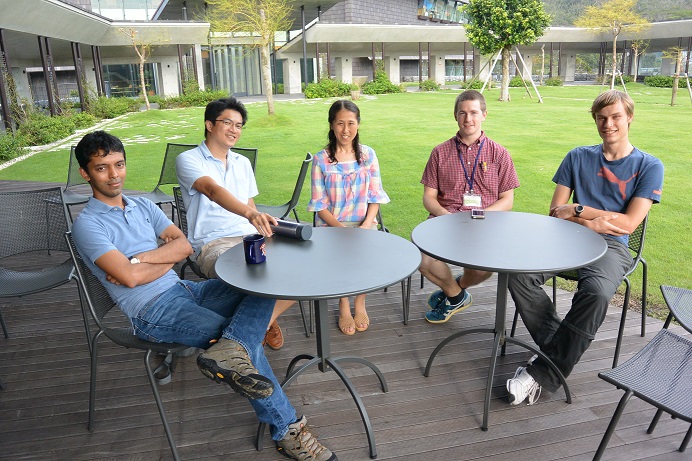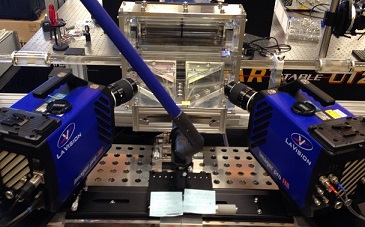FY2013 Annual Report
Fluid Mechanics Unit
Associate Professor Pinaki Chakraborty

Abstract
The Fluid Mechanics unit pursued research on turbulent flows and typhoons, started a new experiment on granular flows, and continued to develop a joint fluid mechanics--continuum physics laboratory
1. Staff
- Dr. Pinaki Chakraborty, Associate Professor
- Dr. Chien-chia Liu, Researcher
- Dr. Carlo Cesar Zuniga Zamalloa, Researcher
- Mr. Christian Butcher, Technician
- Mr. Rory Cerbus, University of Pittsburgh PhD/OIST Special Research Student
- Mr. Hiroaki Hamada, OIST PhD Student (Research Rotation)
- Mr. Keita Ikegami, OIST PhD Student (Research Rotation)
- Ms. Kaori Egashira, Research Administrator
2. Collaborations
- Theme: Turbulent soap films
- Type of collaboration: Scientific collaboration
- Researchers:
- Professor Hamid Kellay, University of Bordeaux, France
- Professor Walter Goldburg, University of Pittsburgh, USA
- Theme: Theory of spectral link in turbulent flows
- Type of collaboration: Scientific collaboration
- Researchers:
-
Professor Gustavo Gioia, OIST
-
- Theme: Rain in typhoons
- Type of collaboration: Scientific collaboration
- Researchers:
- Professor Gustavo Gioia, OIST
- Theme: Experiments on granular cratering
- Type of collaboration: Scientific collaboration
- Researchers:
- Professor Gustavo Gioia, OIST
-
Professor Susan Kieffer, University of Illinois, USA
- Theme: Experiments on turbulent pipe flows
- Type of collaboration: Scientific collaboration
- Researchers:
- Professor Gustavo Gioia, OIST
- Professor Jun Sakakibara, Meiji University, Japan
- Theme: Taylor-Couette experiment
- Type of collaboration: Scientific collaboration
- Researchers:
- Dr. Yasuo Higashi, OIST
- Professor Gustavo Gioia, OIST
- Mr. H. Yamaoka, High Energy Accelerator Research Organization, Tsukuba, Japan
3. Activities and Findings
3.1 Turbulent soap films
The well-known law of the wall and the log law rule the near-wall mean velocity profile of three-dimensional turbulent flows. Using a turbulent soap-film channel, we have conducted the first experimental test of these laws in quasi-two-dimensional turbulent channel flows under two disparate turbulent spectra. We find that despite the differences with three-dimensional flows, the laws prevail, albeit with notable distinctions. Our results suggest that the classical theory of scaling in wall-bounded turbulence is incomplete wherein a key missing element is the link with the turbulent spectrum.
3.2 Theory of spectral link in turbulent flows
We continued theoretical work on new scaling relations for the turbulent-energy spectra in wall-bounded, uniform turbulent flows. These scaling relations---the spectral analog of the law of the wall, the spectral analog of the defect law, and the spectral analog of the log law---apply in the same spatial domain as the attendant scaling relation for the mean-velocity profiles (MVPs). While the classical scaling relations for the MVPs are predicated solely on dimensional analysis and similarity assumptions, the widely adopted approach for deriving scaling relations for the turbulent-energy spectra have been predicated on specific models of wall turbulence, notably the attached-eddy hypothesis. In our approach we use dimensional analysis and similarity assumptions, without invoking any model of wall turbulence, and show that each spectral analog applies in a specific spectral domain, with the implication that there exist model-independent, one-to-one links between the spatial domains and the spectral domains. We verify the spectral analogs using experimental and computational data on pipe flow and channel flow. Further, we verify that the spectral analogs apply to not only the streamwise component of the turbulent-energy spectrum (the most widely studied component of the spectrum) but to the other possible realizations of the turbulent energy spectra.
3.3 Rain in typhoons
We continued work on the effect of falling rain on the intensity of typhoons. Although enormous power is lost to turbulent friction as the raindrops fall through the air in a single typhoon, this "rainpower" has been overlooked in typhoon models, and its effect on the intensity of typhoons remains unknown. By modifying the well-known Emanuel's Carnot-engine model of typhoons in two disparate ways, one corresponding to an adiabatic eyewall and another to a diabatic eyewall, we show that, contrary to the prevalent notion that rain helps drive typhoon winds, the effect of rainpower is to lessen typhoon intensities by about 20%. Our findings have implications for weather and climate-change forecasting.
3.4 Experiments on granular cratering
We have started a new experiment on granular analog of planetary cratering. Our focus is to elucidate the mechanism of ejecta deposits and to relate it with the planetary crater ejecta. This experiment is carried out in a new granular flow laboratory, which we started this year in collaboration with the Continuum Physics Unit.
3.5 Experiments on turbulent pipe flows
In the pipe flow experiment in our laboratory we have been able to achieve very stable flow from laminar to fully turbulent regimes, to measure the pressure drop accurately, and to obtain high-precision, time-resolved Stereoscopic Particle Image Velocimetry (PIV) data for all velocity components in the cross-section of the pipe.

Figure: Setup for Stereoscopic PIV
3.6 Taylor-Couette experiment
We have completed the design, manufacturing, and instrumentation of a small Taylor-Couette experiment in our laboratory. We are currently performing torque measurements in this experiment. This experiment is a prototype for a large Taylor-Couette experiment, for which we have completed the design and manufacturing.
4. Publications
4.1 Journals
1. Cerbus, R.T., & Goldburg, W.I. Intermittency in 2D soap film turbulence. Physics of Fluids 25, (105111-1) ~ (105111-16), (2013).
2. Cerbus, R.T., & Goldburg, W.I. Information content of turbulence. Physical Review E 88, (053012-1) ~ (053012-8), (2013).
3. Samanta, D, Ingremeau, F., Cerbus, R., Tran, T., Goldburg, W. I., Chakraborty, P., & Kellay, H. Scaling of near-wall flows in quasi-two-dimensional turbulent channels. Physical Review Letters 113, (024504-1) ~ (024504-5), (2014).
4.2 Books and Other One-Time Publications
Nothing to report
4.3 Oral and Poster Presentations
1. Chakraborty, P., Gioia, G. & Kieffer, S. Rotating volcanic plumes, in International Association of Volcanology and Chemistry of the Earth's Interior (IAVCEI) Scientific Assembly 2013, Kagoshima, Japan (2013)
2. Lundstrom, C. C., Chakraborty, P. & Zambardi, T. The plutonic-volcanic connection: are we even on the right track?, in American Geophysical Union (AGU) Fall Meeting, San Francisco, California, USA (2013)
3. Lundstrom, C. C., Chakraborty, P. & Zambardi, T. Isotopic insights into the plutonic-volcanic relationship with proposal for a new eruption mechanism., in The Geological Society of America (GSA) Annual Meeting: 125th Anniversary of GSA, Denver, Colorado, USA (2013)
4. Chakraborty, P. & Gioia, G. A spectral theory of turbulent friction on rough and smooth walls, in Workshop on Large scale fluid motion and turbulent fluctuation, Kyoto University, Kyoto (2014)
5. Gioia, G., Guttenberg, N., Goldenfeld, N. & Chakraborty, P. A spectral theory of the mean-velocity profile in turbulent pipe flows, in Workshop on Large scale fluid motion and turbulent fluctuation, Kyoto University, Kyoto (2014)
6. Liu, C.-C., Gioia, G. & Chakraborty, P. Local version of the spectral link in turbulent friction, in Workshop on Large scale fluid motion and turbulent fluctuation, Kyoto University, Kyoto (2014)
5. Intellectual Property Rights and Other Specific Achievements
Nothing to report
6. Meetings and Events
6.1 Seminar
1) Title: The onset of turbulence
- Date: July 29, 2013
- Venue: OIST campus
- Speakers: Prof. Björn Hof (Institute of Science and Technology, Austria)
2) Title: Experimental study of pulmonary surfactant behavior during airway reopening: Application of μ-PIV to the complex multi-phase flow
- Date: August 5, 2013
- Venue: OIST campus
- Speakers: Dr. Eiichiro Yamaguchi (Biomedical Engineering Department, Tulane University, New Orleans, LA)
3) Title: The Spectral Link in Turbulent Frictional Drag and Turbulent Mean Velocity Profile
- Date: December 2, 2013
- Venue: Osaka University
- Speakers: Prof. Pinaki Chakraborty (OIST)
4) Title: The Spectral Link in Turbulent Frictional Drag and Turbulent Mean Velocity Profile
- Date: December 3, 2013
- Venue: Kyoto University
- Speakers: Prof. Pinaki Chakraborty (OIST)
5) Title: Freeman Dyson was right - again: electrical polarization in sandstorms
- Date: January 15, 2014
- Venue: OIST campus
- Speakers: Prof. Troy Shinbrot (Rutgers University, USA)
6) Title: Publishing in Nature: a step by step guide
- Date: January 16, 2014
- Venue: OIST campus
- Speakers: Prof. Troy Shinbrot (Rutgers University, USA)
7) Title: Hydrodynamics using soap films and soap bubbles
- Date: March 13, 2014
- Venue: OIST campus
- Speakers: Prof. Hamid Kellay (University of Bordeaux, France)
8) Title: Information theory applied to fluid flow experiments
- Date: March 14, 2014
- Venue: OIST campus
- Speakers: Prof. Walter Goldburg (Dept. of Physics and Astronomy, University of Pittsburgh)
6.2 Short Course
Title: A short course on Particle Image Velocimetry
- Date: August 16, 2013
- Venue: OIST campus
- Speakers: Prof. Jun Sakakibara (Meiji University)



